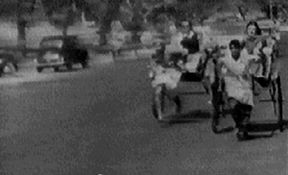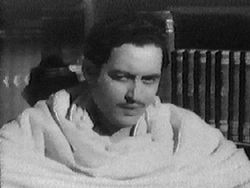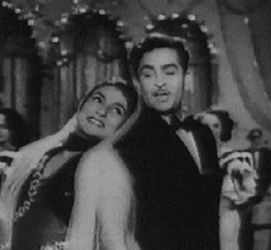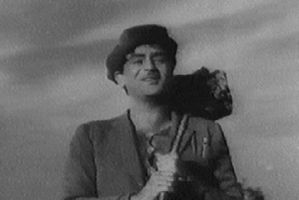 |
Do bīghā zamīn (1953) |
The first notable 'city' in Hindi popular cinema is also Calcutta of Bimal Roy's
Do Bigha Zamin. Very different from the Calcutta of Ray or the 'cities' of Raj Kapoor and
Guru Dutt. This is Calcutta seen through the eyes of an uprooted non-Bengali peasant come to Calcutta to earn money and save his land from the capitalist landlord.
This is the Calcutta of harsh pavements, slums, overworked rickshawallas. Bimal Roy's film is one of the few attempts in a cinema to view the city from the point of view of the casual labourer and the city proletariat. Ray, Sen, Ghatak, Raj Kapoor and Guru Dutt films have one common feature despite great differences. Their vision is middlemiddle or lower middle class. Bimal Roy's movie is the odd film out. Neo-realism is married to the public's need for song and melodrama. The peasant's life despite miseries is romanticised as never before or since. "Haryala savan dhol bajata aya" (Verdant monsoon come beating its drum) is perhaps the loveliest peasant song on our screen.
Calcutta is bleak. It's bleak in a soul crushing, animal fashion. Perhaps it is Balraj Sahni's craggy integrity, perhaps it's the sombre camera craft but the world evoked is one of profound hopelessness and powerlessness. In Satyajit Ray's most pessimistic film, in Raj Kapoor's tamashas, in Guru Dutt's chronicles of despair, there's a sense of an important, if hopeless battle being fought. In Bimal Roy's film the scale of battle itself is reduced - a rickshaw's race to death to save two meagre bighas. There's an absence of transcendence, a deliberate achievement of the most naked kind of secularism that's the hallmark of the genuinely leftist ideological film. The value of the city in human terms is examined and rejected because it is irrelevant to the peasant.
And yet Do Bigha Zamin created some stereotypes which persist to this day. There's the streetwise but uncynical city urchin played brilliantly by Jagdeep. You can be a citizen and yet remain human.There's the warmth, the togetherness of the slums caught unforgettably in the "Ajab teri duniya" (What a strange world this of yours, oh Lord!) song. This song is a cry of the peasants uprooted from their land in a huge metropolis, They have created a home for themselves and it is from this vantage point of their artificial home that they judge the ruthless world around. The Bombay of Raj Kapoor and Guru Dutt (though the latter shot many scenes in Calcutta) is a far cry from the Calcutta of Ray and Bimal Roy. First, there is the economic and social difference. There is an air of decline about Calcutta, of things falling apart. In Bombay there is a thrust, there's a drive, there's a vigour which suffuses even the chawls. This is a felt, actual difference and not a creation of cinema. But it is exploited by the artists in different ways. While Ray maintains a distance, takes his time to chart the changing Calcutta over three decades, Kapoor and Dutt, so to say, jazz up the pace of change, reduce the character of Bombay to certain stereotypes, and give an indulgent play to their fantasies and (in the case of Dutt) to despair. The City becomes an over-obvious metaphor. And yet the idiosyncratic elements and the social comment in Kapoor-Dutt films deserve analysis because they set the pattern for the form and content of popular cinema till the eighties.
The structure and elements of the Kapoor-Dutt cities will be set down before a brief examination of four films - Awaara, Shree 420, Pyaasa and Kaagaz Ke Phool.
The Structure of the city:
- There's an upper/upper middle class consisting of judges (Awaara), successful publishers (Pyaasa), anglicised rentiers (Kaagaz Ke Phool) and noveau riches in league with decadents (Shree 420). There's an 'adversary culture' critique of this class.
- There's a middle/lower middle class hero who is the adversary (more intense in Dutt). He may be a lost son (Awaara), a rootless, goodhearted and moral vagabond (Shree 420) or an artist (Pyaasa and Kaagaz Ke Phool).
- Then there are the genuine outsiders - the apaches - dacoit-killers (Awaara), the prostitutes (Pyaasa) and the slum crowd (in all four films).
Women of the city:
This topic deserves an entire chapter to itself. Here I shall concentrate on two broad 'types' of women observed in Kapoor-Dutt films.
The first type is the cool, sophisticated, aloof, not easily 'attainable' type, represented by Nargis in Awaara, Nadira in Shree 420, Mala Sinha in Pyaasa and Veena in Kaagaz Ke Phool.
It will be said that there are vast differences in the personalities of these women. Nargis is warm-hearted she falls for a tramp, Nadira is a smalltime racketeer. Mala Sinha is a sold-out socialite. Veena is the contemptuous, high aristocratic type.
These are personality differences. I am thinking of the way these women must have appeared to the 'heroes' of the four films - shiftless tramps, failed poets, unsteady filmmakers. All these four women are used to money, they have the style which only long acquaintance with money or being born into a good family can bring. Baudelaire caught the essence of this quality in his line: "The softness that fascinates, the pleasure that kills". Hitchcock was frank in his work about his fascination for such women. Kapoor and Dutt are not (though Kapoor made some amends later in Mera Naam Joker). These women are seen as faithless or hard. Even Nargis in Awaara is savaged by Raj Kapoor (see below). But there's an undercurrent of admiration for such women because of their elegance - see the 'dream' sequences in Awaara and Pyaasa and more important watch the ethereal way Nargis and Mala Sinha are conjured up ("Ghar aaya mera pardesi" [È venuto a casa il mio straniero] and "Hum aapki aankhon Mein" [Io nei tuoi occhi] sequences).
"This is love which makes the lover burn in its flame," as Walter Benjamin says in another context, "but no phoenix arises from it."
It is interesting to contrast this image with the way the 'other' women - the marginal women are handled. Waheeda in Pyaasa is a street walker. She becomes a 'fallback' woman for Guru Dutt - in fact, in one of the most revealing shots in our cinema, Dutt slites down in her embrace in total defeat. The prostitute by a strange reversal takes on the role of the 'Indian wife' - a-taken-for-granted source of recuperation towards health. In effect this is the role Waheeda plays in Kaagaz Ke Phool too. But it must be pointed out that Kaagaz Ke Phool... is suffused with the lacerating passion of hopeless love - a tragedy which is not fully worked out. Nargis in Shree 420 is a do-gooding school mistressy, voice of conscience - an image which is not weakened by those Hollywoodish shots of romance in the rain. She is a figure of salvation, of escape from the city rather than'object of desire' in the city.
In a sense, in choosing the 'marginal' women, the men are settling for the second best. To quote Baudelaire again, "Who gives to prostitutes his lovells happy, satisfied and free / My hands are broken utterly / For having grasped the clouds above". A very resigned 'city' conclusion .
The Poetry of the city:
 |
Pyāsā (1957) |
Sahir, Hasrat, Shailendra and a host of others created the poetry of the city - "A chorus of voices rising from the abyss of history". It is this which gave the cinematic city of the fifties its most distinctive mark. This poetry assimilated the simplicities of rural speech, the intensity of
bhakti, the devotion of the
qawwali, the banality of the Bombay patois, the Persian sensuousness of the
ghazal and the fire of revolutionary zeal. A good illustration of the multifaceted nature of such poetry will be to take the single film
Pyaasa. Beginning from the Persian sensuousness of the very first line of
Pyaasa, "
Yeh hanste hue phool, ye mahakta hua gulshan" (These smiling flowers, this fragrant garden) to Johnny Walker's "
Sar jo tera chakrae (If your head reels...) and on to the ultimate
bhakti song
Aaj sajan mohe ang lagale (Embrace me today, my beloved) we traverse the whole spectrum of Indian lyrical and popular cultures. When all else is forgotten, the poetry of the fifties cinema which both celebrated and excoriated the city, will remain.
The End of the Affair:
Awaara accepted the city - its slums and its palaces. Shree 420 and Pyaasa fled the city. The artist of Kaagaz Ke Phool consummated his love-hate affair with the city in death.
The individual geniuses of Raj Kapoor and Guru Dutt in their creations of the city deserves elaboration. For Raj Kapoor the city is a tamasha, a roller coaster ride, fair game for a vagabond or a tramp (too obviously Chaplinesque). A critic called his work a "canny compromise between art and commercial experiences". I do not think Kapoor made such a calculated decision. Of course, everyone is in this business to make money. But our business is to judge the vision from the work. And the Kapoor vision was - and remained - a surface vision. This is no denigration. Perhaps this approach extracted a truth about the city not open to more tortured souls - that its glitter its show its seductiveness has undeniable power When Kapoor puts his vision into Madame Simki's fantasy - Kapoor struggles up a vast staircase to an ethereal Nargis only to be dragged down by masked devils. Here he expresses both his detestation for urban lower depths and his infatuation with affluence. "There's money in her voice," says Gatsby fascinated by Daisy (The Great Gatsby, F. Scott Fitzgerald). It is the culture which money has bought that fascinates Awaara's hero. In a significant scene Kapoor savages Nargis for being what she is, implicitly for being a social success - and Nargis clasps his knees in surrender. Which is no doubt a scene where Kapoor is seen as hating himself for being in love with a woman of the 'upper class' but a conclusion of the sequence shows that 'love' wins over 'hate'. No, success is not a bitch goddess in Awaara.
 |
Shree 420 (1955) |
But she becomes one in
Shree 420 made four years later (1955). Whereas the world of the tramp and the world of the society goddess is fused at the end in
Awaara (with a lot of alibis, of course), in
Shree 420 both the hero and the girl forsake the city and its world of power. Of course, this could be an accident. rhe same story and screenplay writers were involved in both films - K.A. Abbas and V.P. Sathe. Is it merely a neat reversal of the formula? That possibility is there since Kapoor is neither a classicist like Ray nor a romantic like Guru Dutt. Whatever the reason
Shree 420 looks at the city from the opposite view point to
Awaara. The hero here - unlike the streetwise hero of
Awaara - is an ingenue who discovers the city - the warmth of its slums - and the pseudo warmth of the nouveau riche. He is successful in both worlds - a brilliant pointer to the link between the urban 'legitimate' and 'illegitimate' sectors. Of course, the point is muffled. In
Awaara 'society' is blamed for slum crime; in
Shree 420 the slums are pure as driven snow and the crime is in 'society'. But my point is different. The two films in their distorted way reflect urban actuality - the mutual co-existence of two apparently opposed orders, and their strong linking which is established by the ease with which the hero passes from one order to another. Despite the inequality, the hero shows exceptional social mobility.
 |
Shree 420 (1955) |
The heroes of both
Awaara and
Shree 420 have certain common features: they are rootless, without any traditional faith,they are dandies, they are actual or potential criminals. They have the gift of tongues. Kapoor can sing "
Ramayya vastawayya" in the
chawl to establish bonds which are both slum and rural. He can also sing the song of the rising new urban class "
Mud mud ke na dekh" (Do not turn back, do not look back) - cavorting away with Nadira from the tradition-bound schoolmistressy upholder of old values, Nargis.
The song in Hindi films of the fifties was epiphony - a sudden illumination - which substituted for visual devices. Kapoor made use of it to create the archetypal modern urban hero.
For Guru Dutt the city was not a tamasha; it was an 'adversary' using the word in Trilling's sense of an overall cultural confrontation. The paradox was that Dutt's hero as artist in Pyaasa and Kaagaz Ke Phool is a product of the city - the fame he craves can only be bestowed by its patrons and its crowds. It is the working out of this tension between the instinct to fight the adversary and the craving for fame that make Pyaasa and Kaagaz Ke Phool unforgettable. Even love is subsumed by this tension.
Guru Dutt is the great romantic of the city just as Ray is its great classicist. Dutt is searching for the "discovery and discrimination of inward reality for a new wholeness, a new totality". In both his films art becomes a substitute for philosophy and religion. It's through art that the poet challenges the chaining of women into brotheldom "Jinhen Naaz Hai Hind Par / Woh Kahan Hai" (Where are those who are proud of India). It's through art that he challenges "thrones, crowns, palaces". The whole scene in Pyaasa where the living poet's funeral oration is being delivered, signifies the burial of dissent by acceptance óf its 'text' when the dissenter is dead. In fact the scene is shot as if in the vault of a tomb. Dutt's entry, illuminated as if he were a risen Christ, constitutes a challenge to 'acceptance'.
Pyaasa's last scene has worried many. Why did not the poet 'fight'? I think Pyaasa and Kaagaz Ke Phool have to be read together, 'Fight' against the city as constituted today can only lead to co-optation. As in the case of the hero of Jana Aranya the city proves a trap. Ray being a classicist arrives at the conclusion in a different fashion. The classicist is without illusions, without daydreams, without hope, without bitterness and with an abundant resignation.
Guru Dutt being a romantic, saves himself and his art by 'flight' in Pyaasa - for the very 'success' of his art would spell its doom. In Kaagaz Ke Phool he does the same thing by 'retreat'. He retreats into the 'inner city' of unreality - cinema itself. Gradually both the film director and his actress begin to live in the studio - their romance is lighted by beams from studio lights. Even love comes to the director via a close up of Waheeda seen by chance during a showing of rushes. Rejected by the city, art flees to the mausoleum. Even death becomes the acting out of a fantasy.
About Guru Dutt's suicide or death, both in Kaagaz Ke Phool as in life, I think the words of critic Leon Daudet written in 1930 after he had looked at Paris from an elevation are relevant,"A man needs work, that is correct but he has other needs too. Among his other needs there is suicide, something that is inherent in him and the society which forms him, and it is stronger than his drive for self-preservation".
The death of Guru Dutt, seen in the proper perspective, was both noble and inevitable. The city proved too much for him.
The fifites were the last period in Indian cinema when excellence and popularity did not contradict each other when the distinction between 'art' and 'commercial' cinema made no sense. After that the spiritual energy that made for artistic excellence was absorbed by the modernist, highbrow movement of new cinema while popular cinema degenerated into a banal reiteration of 'wholesome' bourgeois themes (less wholesome today, but still bourgeois).
The clock cannot be turned back. But today when both new and old cinema are under pressure, one can look at the fifties classics with a fresh eye-for illumination, if not for imitation.